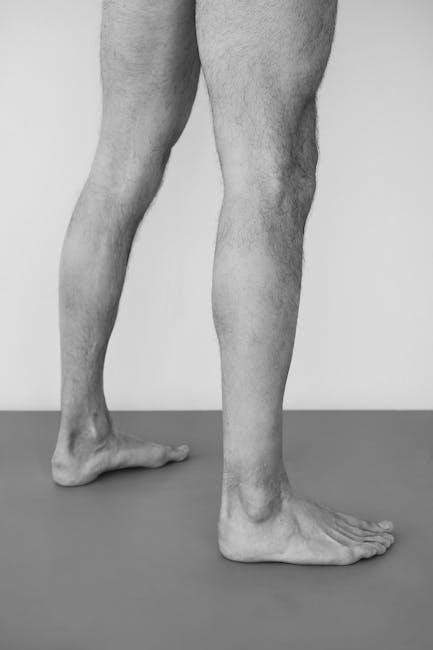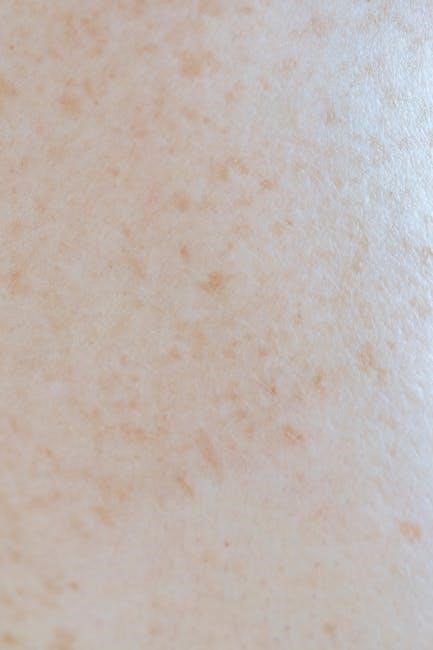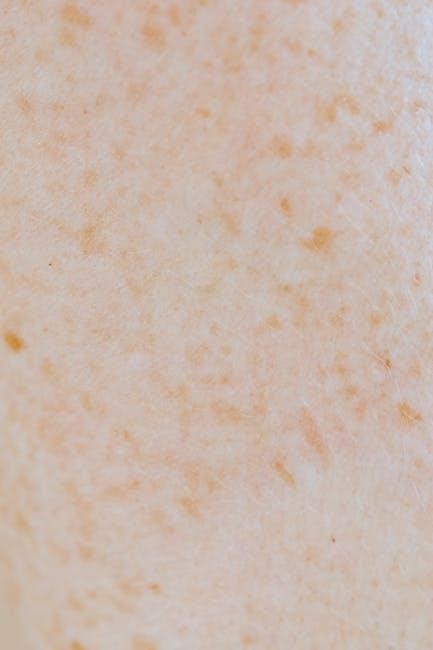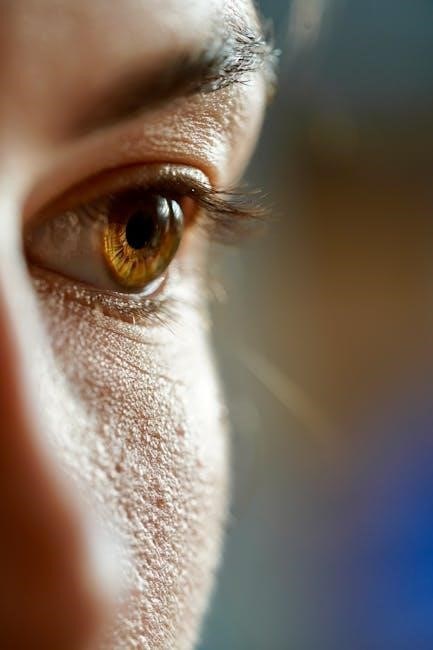This comprehensive, hands-on guide is designed for healthcare students, featuring experiments that explore the structure and function of the human body. It integrates Marieb’s artwork and adapts to any A&P textbook, providing a detailed and interactive learning experience.
1.1 Purpose and Structure of the Lab Manual
The purpose of this lab manual is to guide students through hands-on experiments, fostering a deeper understanding of human anatomy and physiology. Structured for two-semester courses, it includes pre-lab, lab, and post-lab activities, along with anatomical models, histology atlases, and lab videos. Designed to accompany any A&P textbook, it helps manage time and enhance learning both inside and outside the classroom, integrating seamlessly with online platforms like Mastering A&P for a comprehensive educational experience.
1.2 Importance of Lab Work in Understanding Human Anatomy and Physiology
Lab work is crucial for understanding human anatomy and physiology as it provides practical, hands-on experience with biological structures and physiological processes. Through experiments and dissections, students gain a tangible understanding of how systems function, fostering active learning and engagement. Labs also enhance critical thinking and problem-solving skills, enabling students to apply theoretical knowledge in real-world scenarios. This experiential learning bridges the gap between classroom concepts and clinical practices, preparing healthcare professionals for future challenges.

Essential Laboratory Tools and Equipment
This section outlines the fundamental tools and equipment required for anatomy and physiology labs, including microscopes, dissection tools, and physiological monitoring devices, ensuring effective experimentation and analysis.
2.1 Microscopes and Their Use in Anatomy Studies
Microscopes are essential tools in anatomy labs, enabling detailed examination of tissues and cells. Compound light microscopes are commonly used for studying histological slides, offering magnification and illumination for clear observation of microscopic structures. They are integral in understanding cellular functions and tissue organization, aiding students in correlating anatomical structures with physiological processes. Proper use and maintenance of microscopes ensure accurate observations, making them indispensable for hands-on learning in human anatomy and physiology studies.
2.2 Dissection Tools and Their Proper Handling
Dissection tools, such as scalpels, forceps, and probes, are vital for exploring anatomical structures. Proper handling ensures safety and precision, preventing damage to specimens and allowing detailed examination. Students are taught to use each tool appropriately, maintaining control and care to preserve tissue integrity. Regular sterilization and organized storage of instruments are emphasized to maintain lab hygiene and efficiency, fostering a professional and effective learning environment for anatomy studies;
2.3 Physiological Monitoring Devices
Physiological monitoring devices, such as ECG, blood pressure monitors, and pulse oximeters, are essential for measuring vital signs in lab experiments. These tools provide real-time data on heart activity, oxygen saturation, and respiratory rates, enabling students to observe and analyze bodily functions. Regular use of these devices helps students understand how the body maintains homeostasis and prepares them for clinical applications in healthcare settings, ensuring practical experience with physiological data collection and interpretation.

Basic Anatomy and Physiology Concepts
This section introduces foundational knowledge of human anatomy and physiology, focusing on essential structures and functions. It provides a clear understanding of bodily systems and their interactions through hands-on exercises and detailed visual aids.
3.1 Overview of Tissues and Their Functions
This section introduces the four primary tissue types in the human body: epithelial, connective, muscle, and nervous. It explores their unique structures, functions, and roles in maintaining homeostasis. Through microscopic studies and histological examinations, students identify and classify tissues, understanding their significance in forming organs and systems. Interactive lab exercises, including virtual simulations, enhance comprehension of how tissues contribute to overall bodily functions and specialized processes.
3.2 Understanding the Skeletal and Muscular Systems
The skeletal system, comprising bones and joints, provides structural support and protection. The muscular system, made up of muscles, enables movement and maintains posture. Lab exercises involve examining bone structures, joint types, and muscle tissues through dissections and microscopic observations. Students learn to identify different muscle types, such as skeletal, smooth, and cardiac muscles, and understand their roles. This section focuses on the practical identification and functional analysis of the skeletal and muscular systems, highlighting their interdependence in facilitating movement and maintaining bodily functions.
The nervous system, including the brain, spinal cord, and nerves, controls bodily functions and communication. The circulatory system, comprising the heart, blood vessels, and blood, transports oxygen and nutrients. Lab activities include examining nervous tissue slides, observing blood smears, and simulating neural and circulatory processes. These exercises help students understand how the nervous system regulates body functions and how the circulatory system maintains homeostasis through blood flow and oxygen delivery.

Histology and Cellular Physiology
This section explores the microscopic study of tissues and cellular functions, focusing on tissue identification, cellular transport mechanisms, and physiological processes like respiration and reproduction.
4.1 Preparing and Examining Histological Slides
Preparing histological slides involves obtaining tissue samples, fixing, sectioning, and staining to preserve and enhance cellular details. Students learn to handle microscopes for detailed tissue examination, identifying structures and their functions. This process helps correlate microscopic anatomy with physiological processes, aiding in disease diagnosis and understanding tissue organization. Proper techniques ensure clear visualization, making histology a foundational skill in anatomy and physiology studies. Digital tools often supplement microscopy, offering enhanced views and interactive learning experiences.
4.2 Cellular Structure and Function
Understanding cellular structure and function is fundamental to anatomy and physiology. Cells are the basic units of life, with components like the cell membrane, cytoplasm, and organelles working together to maintain homeostasis. Labs focus on identifying cellular structures under microscopes and exploring processes like transport, metabolism, and reproduction. Interactive simulations and digital tools enhance learning, illustrating how cells contribute to tissue and organ functions. This knowledge is crucial for grasping disease mechanisms and physiological processes at the most basic level.
4.3 Laboratory Exercises on Tissue Identification
Laboratory exercises on tissue identification involve hands-on activities with histological slides and digital atlases. Students learn to distinguish between epithelial, connective, muscle, and nervous tissues under a microscope. These exercises emphasize understanding tissue composition, function, and organization. Interactive tools and virtual simulations enhance visualization of tissue structures. Practical identification skills prepare students for clinical applications, reinforcing the connection between tissue types and their roles in organ systems. This section focuses on developing observational and analytical skills critical for advanced anatomical studies.

Laboratory Exercises and Experiments
This chapter focuses on hands-on activities, including physiological measurements, simulations, and dissections. It integrates practical exercises with digital tools to enhance understanding of anatomical and physiological concepts through direct observation and application.
5.1 Measurement of Physiological Parameters
This section introduces students to essential techniques for measuring physiological parameters such as heart rate, blood pressure, and respiratory rate. Hands-on exercises using tools like EKGs, sphygmomanometers, and pulse oximeters allow students to collect and analyze data. These activities help students understand the interconnectedness of body systems and how they maintain homeostasis. Emphasis is placed on accurate data recording, interpretation, and correlating findings with anatomical structures and their functions. This practical approach enhances comprehension of physiological processes and their clinical relevance.
5.2 Simulations and Virtual Labs in Physiology
5.3 Practical Dissection of Specimens
Practical dissection of specimens, such as cats and fetal pigs, provides hands-on experience with anatomical structures. Students learn proper techniques for handling tissues and identifying organs. Dissection reinforces classroom concepts, allowing visualization of spatial relationships between systems. Safety protocols and correct tool usage are emphasized. This experiential learning enhances understanding of human anatomy, bridging gaps between theory and application. The lab manual guides dissections with detailed instructions, ensuring a structured and informative experience for students.

Anatomy and Physiology of Major Body Systems
This section explores the integrated functions of the respiratory, digestive, urinary, nervous, and circulatory systems, emphasizing their roles in maintaining homeostasis and overall bodily harmony through practical lab exercises.
6.1 Respiratory System: Structure and Function
The respiratory system, essential for gas exchange, includes the nose, trachea, bronchi, and lungs. Lab exercises explore breathing mechanisms, lung capacity, and oxygen-carbon dioxide exchange. Students examine histological slides of lung tissue and conduct spirometry to measure airflow. Simulations and dissections deepen understanding of how the respiratory system maintains homeostasis and supports cellular respiration. Practical activities emphasize the integration of anatomical structures with physiological functions, preparing students for real-world applications in healthcare.
6.2 Digestive System: From Mouth to Intestine
The digestive system transforms food into nutrients through mechanical and chemical processes. Labs explore the pathway from ingestion to absorption, analyzing structures like the mouth, esophagus, stomach, pancreas, liver, and intestines. Activities include histological slide examinations of intestinal tissues and simulations of digestion. Students investigate enzyme functions and nutrient absorption mechanisms, gaining a hands-on understanding of how the digestive system processes food and maintains overall bodily function through intricate physiological processes.
6.3 Urinary System: Filtration and Excretion
The urinary system filters blood to produce urine, removing waste and excess substances. Labs explore kidney structure, including nephrons, and their role in filtration. Activities include microscopic examination of kidney sections and simulations of urine formation. Students study the ureters and bladder, focusing on the excretion process. Histological slides highlight the glomeruli and tubules, while experiments demonstrate fluid balance and pH regulation, essential for homeostasis. This section provides a detailed understanding of how the urinary system maintains bodily health through filtration and excretion.

Laboratory Safety and Biohazard Protocols
This section emphasizes proper use of PPE, safe handling of biological specimens, and emergency procedures to ensure a secure lab environment for all students and instructors.
7.1 Proper Use of Personal Protective Equipment
Personal Protective Equipment (PPE) is essential in anatomy and physiology labs to prevent exposure to biological hazards. Common PPE includes gloves, lab coats, goggles, and face masks. Proper handling and disposal of PPE are critical to maintain safety. Always wear gloves when handling specimens or chemicals and ensure lab coats are tied securely. Goggles protect eyes from splashes, while masks prevent inhalation of harmful substances. Improper use of PPE can lead to contamination and health risks, emphasizing the need for strict adherence to safety protocols.
7.2 Handling and Disposal of Biological Specimens
Proper handling and disposal of biological specimens are critical to prevent contamination and exposure to pathogens. Always wear gloves and lab coats when handling specimens. Use leak-proof, biohazard-labeled containers for storage and disposal. Specimens should be sealed and labeled clearly before disposal. Dispose of sharps in designated containers to prevent injury. Follow institutional protocols for autoclaving or incineration of biological waste. Double-bagging specimens ensures safe transport to disposal areas. Wash hands thoroughly after handling specimens, and decontaminate surfaces to maintain a safe lab environment.
7.3 Emergency Procedures in the Lab
Emergency procedures are essential to ensure safety in the lab. In case of fires, evacuate the area immediately and use fire extinguishers rated for chemical or biological hazards. Spills of hazardous materials require containment and neutralization using appropriate kits. For chemical exposure, flush affected areas with water and seek medical help. Injuries involving biological specimens should be treated with immediate washing and reporting. Keep emergency contact numbers accessible, and conduct regular drills to prepare for unforeseen incidents. Always maintain a first aid kit and eye wash station nearby.

Digital Resources and Supplements
Digital resources include online simulations, interactive models, and virtual labs, enhancing learning through interactive anatomy and physiology exploration. Tools like PhysioEx and BIOPAC exercises provide hands-on experience remotely.
8.1 Online Simulations and Interactive Models
Online simulations and interactive models provide engaging ways to explore human anatomy and physiology. Tools like PhysioEx offer virtual labs with exercises on physiological processes. Interactive 3D models allow students to visualize complex structures, enhancing understanding of spatial relationships. These resources often include animations and quizzes to reinforce learning. They are accessible via web browsers and mobile devices, making them ideal for both classroom and remote learning environments. Such digital tools complement traditional lab work, offering flexible and immersive educational experiences for students.
8.2 Digital Histology Atlases
Digital histology atlases provide high-resolution images of histological slides, enabling students to examine tissue structures in detail. These resources often include zoom and pan features, labels, and descriptions to aid in identification. Atlases are integrated with lab manuals and virtual labs, offering a comprehensive learning experience. They replace the need for physical microscopes, making histology more accessible and engaging. Many atlases also include tutorials and quizzes to test understanding, reinforcing key concepts in tissue identification and cellular physiology.
8.3 Accessing Virtual Lab Platforms
Virtual lab platforms provide interactive simulations and 3D models to explore human anatomy and physiology. These tools offer real-time experiments, allowing students to conduct dissections, observe physiological processes, and analyze data. Platforms like PhysioEx integrate with lab manuals, enabling a seamless learning experience. Accessible online, virtual labs support self-paced learning and can be used alongside traditional lab activities. They enhance engagement and understanding, making complex concepts more tangible and easier to visualize through dynamic, immersive experiences.
Laboratory Report Writing and Presentation
This section guides students in structuring lab reports, analyzing data, and presenting findings effectively. It emphasizes clear communication, proper formatting, and the use of visual aids for impactful presentations.
9.1 Structuring a Lab Report
A well-structured lab report includes a title page, introduction, materials list, procedures, results, discussion, conclusion, references, and appendices. The introduction outlines the lab’s purpose and objectives, while the materials and procedures sections provide clarity on the methods used. Results present data objectively, and the discussion interprets findings, linking them to broader concepts. The conclusion summarizes key outcomes, and references cite all sources. Appendices may include raw data or supplementary materials, ensuring transparency and completeness in documentation.
9.2 Data Analysis and Interpretation
Data analysis involves organizing and interpreting lab results to draw meaningful conclusions. This includes calculating statistical measures, identifying trends, and comparing data to expected outcomes. Use graphs, charts, and tables to visually represent findings, enhancing clarity. Interpretation connects results to the lab’s objectives, explaining biological significance and implications. Discuss potential sources of error and their impact on results, ensuring a critical and transparent evaluation of the experiment’s outcomes.
9.3 Effective Presentation Techniques
Effective presentations involve clear communication of lab findings, using visuals like diagrams and graphs to enhance understanding. Organize content logically, starting with objectives and ending with conclusions. Practice delivery to ensure confidence and clarity. Use tools like PowerPoint to create visually appealing slides, avoiding clutter. Encourage audience engagement with questions and discussions. Highlight key results and their biological significance, ensuring the audience grasps the lab’s importance and relevance to human anatomy and physiology.

Troubleshooting Common Lab Issues
This section addresses common lab challenges, such as equipment malfunctions and specimen handling issues, providing practical solutions and maintenance tips to ensure smooth lab operations.
10.1 Resolving Technical Difficulties with Equipment
Technical issues with lab equipment, such as microscopes or physiological devices, can hinder progress. Regular maintenance and calibration are essential to prevent malfunctions. If equipment fails, check power sources, connections, and software updates. For microscopes, ensure proper lens cleaning and focus adjustment. Dissection tools may require sharpening or replacement of blades. If issues persist, consult user manuals or contact technical support. Troubleshooting early helps minimize downtime and ensures smooth lab operations.
10.2 Overcoming Challenges in Dissection
- Dissection challenges often arise from delicate tissues or complex anatomical structures.
- Use precise tools, follow step-by-step guides, and maintain specimen integrity.
- Practice proper handling to avoid damage and ensure accurate observations.
- Leverage resources like histology atlases or virtual simulations for better understanding.
10.3 Addressing Safety Concerns
Safety is paramount in anatomy and physiology labs. Proper use of personal protective equipment (PPE) like gloves and goggles is essential to prevent exposure to biohazards. Students should follow strict protocols for handling and disposing of biological specimens. Emergency procedures, such as spill cleanup or injury response, must be clearly understood and practiced. Regular training and adherence to lab rules ensure a secure environment for all participants, minimizing risks and fostering a focused learning atmosphere.

Review and Assessment
This section provides review sheets for key concepts, practice questions, and guidelines for the final lab project, ensuring comprehensive understanding and preparedness for assessments.
11.1 Review Sheets for Key Concepts
Review sheets for key concepts provide concise summaries of major topics, reinforcing learning and aiding retention. Organized by chapter or lab activity, they highlight essential terms, processes, and structures. These sheets often include concept maps, diagrams, and self-test questions to ensure mastery of fundamental principles. They serve as valuable study tools for exams and quizzes, helping students connect theoretical knowledge with practical lab experiences. Regular review of these materials enhances understanding and prepares students for comprehensive assessments.
11.2 Practice Questions and Quizzes
Practice questions and quizzes within the lab manual are designed to reinforce learning and assess understanding of key concepts. These interactive tools cover a wide range of topics, from cellular physiology to major body systems. Multiple-choice, true/false, and short-answer formats are included to cater to different learning styles. Regular quizzes help students identify knowledge gaps and improve retention of complex anatomical and physiological principles. Answers and explanations are provided to facilitate self-assessment and preparation for exams.
11.3 Final Lab Project Guidelines
The final lab project is a comprehensive assignment that integrates concepts learned throughout the course. Students are required to complete an in-depth study of a selected body system, incorporating histological observations, physiological data, and applied case studies. The project includes a detailed report, presentation, and reflection on laboratory experiences. Guidelines emphasize clarity, scientific accuracy, and critical thinking. Submissions must adhere to specific formatting and deadlines, with thorough feedback provided to enhance learning outcomes and prepare students for advanced studies in healthcare fields.